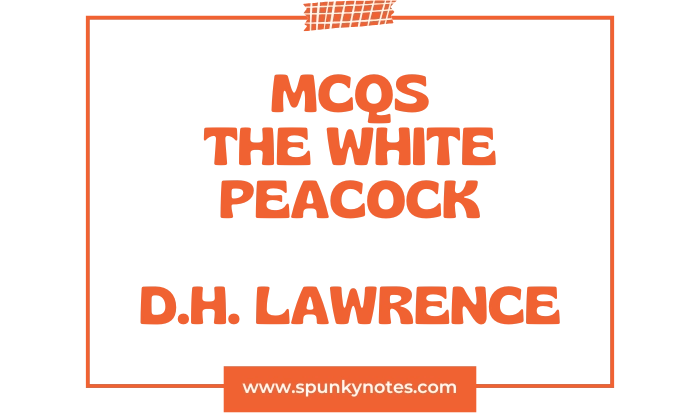

Estimated Reading Time: 17 min
The White Peacock MCQs
1. What is the name of the mill pond where Cyril observes the fish?
A. Highclose Pond
B. Nethermere
C. Strelley Brook
D. Eberwich Mere
2. How does Cyril describe the atmosphere of the valley?
A. Youthful tumult
B. Gathered in the musing of old age
C. Wild and chaotic
D. Quiet and barren
3. What does George do with the clustered eggs of the insects?
A. Puts them back
B. Flings them into the water
C. Gives them to Cyril
D. Examines them scientifically
4. Who insists that Cyril stay for dinner at the Saxtons’ house?
A. George
B. Emily
C. The father
D. His mother
5. How is the father (Mr. Saxton) described upon entering?
A. Thin and stern
B. Big burly farmer
C. Quiet and scholarly
D. Young and anxious
6. What does Emily compare George to in an irritating remark?
A. A lazy dog
B. A fat fool
C. A fatted calf
D. A spoiled child
7. How does Cyril describe his own sense of responsibility?
A. As firm as a rock
B. As irresponsible as a puff of wind
C. Driven by duty
D. Always mindful of promises
8. What does Lettie ask Cyril about George?
A. If he is married
B. If he plans to leave the farm
C. If he has found a girl yet
D. If he is moving to London
9. How does Mother sarcastically describe George?
A. A true gentleman
B. An unlicked cub
C. A brilliant scholar
D. A suitable match for Lettie
10. How tall is Lettie described as being?
A. Petite
B. Nearly six feet
C. Average height
D. Quite short
11. What creature do Cyril and Lettie find injured and decide to take home?
A. A wounded rabbit
B. A cat (Mrs. Nickie Ben)
C. A sick dog
D. A fledgling bird
12. What method does George ultimately use to kill Mrs. Nickie Ben?
A. Crushing it
B. Drowning it
C. Shooting it
D. Poisoning it
13. When George enters the parlor after washing, what visual detail draws Lettie’s gaze?
A. His dirty boots
B. His solid and white breasts and arms
C. His torn breeches
D. The towel he is holding
14. How does George say the Schubert romance music made him feel?
A. Enlightened
B. Happy
C. A fool
D. Sentimental
15. Who arrives to interrupt the group’s supper at Strelley Mill?
A. Cyril’s mother
B. Leslie
C. Alice Gall
D. Mr. Saxton
16. How does George subtly insult Leslie and Lettie by discussing farm matters?
A. By mentioning the manure pile
B. By talking about the red heifer calving
C. By complaining about the field work
D. By detailing cow illnesses
17. What is the nickname Cyril calls George, and Lettie uses later?
A. Mon Cœur
B. Mon Taureau
C. Mon Ami
D. Mon Petit
18. What wakes the disheveled, sleeping man in the wood?
A. Cyril shouting
B. A dog barking
C. The scream of a rabbit
D. The twilight gloom
19. What does Lettie suggest is necessary before one can “blossom” in life?
A. Reading books
B. Good living
C. Suffering
D. Travel
20. What picture makes George exclaim, asking if a girl like that, “half afraid,” wouldn’t be “fine”?
A. Watts’ “Hope”
B. Millais’ “Ophelia”
C. Griffinhagen’s “Idyll”
D. Blake’s figures
21. What character does Lettie mockingly call George when reacting to his passion?
A. Precious Sir Galahad
B. Bully Bottom
C. Old Adam
D. My Adonis
22. What is Cyril’s father’s name?
A. Leslie
B. George
C. Frank Beardsall
D. William
23. Where do Cyril and Mother travel to upon receiving the final letter?
A. Nottingham
B. Cossethay
C. Highclose
D. Eberwich
24. The father’s death changes Lettie and Cyril’s lives, creating a “new consciousness” and what else?
A. A sense of freedom
B. A new carefulness
C. Great sorrow
D. Financial hardship
25. What do George and Leslie do enthusiastically after a rabbit breaks cover?
A. Discuss hunting ethics
B. Set the dogs on it
C. Join the chase
D. Go back to work
26. What happens immediately after the rake strikes the second rabbit?
A. Cyril feels a hot pain
B. Leslie drops his scythe
C. George laughs
D. Emily faints
27. What is the name of the squire’s saturnine keeper?
A. Halkett
B. Annable
C. George
D. Tempest
28. What does Cyril crown Emily with after she kills the dog?
A. Oak leaves
B. Ivy
C. Mountain-ash berries
D. Wild roses
29. What does Cyril say Emily cares for instead of the “flesh of the apple”?
A. The eternal pips
B. The leaves
C. The sweetness
D. The color
30. Following her inheritance, what literary material does Lettie read?
A. Books on farm life
B. Modern novels
C. Texts dealing with modern women
D. Poetry
31. What kind of jewels are set in the engagement ring Leslie gives Lettie?
A. Rubies and gold
B. Pearls and diamonds
C. Sapphires and diamonds
D. Emeralds and silver
32. Lettie tells George that people are “all chess-men,” and that she couldn’t help getting engaged because…?
A. Leslie trapped her
B. Her mother insisted
C. She was bound to do what people expected
D. It was the best financial move
33. Who is the keeper who accosts Lettie and Leslie in the dell of snowdrops?
A. Tom
B. Leslie
C. Annable
D. George
34. Where does George finally announce his intention to marry Meg?
A. At the Mill supper table
B. In the barn
C. In London
D. At the Ram Inn
35. What artwork does Cyril show Emily and George (which George keeps)?
A. Waterhouse’s Lady of Shalott
B. Beardsley’s “Atalanta” and “Salome”
C. Clausen’s “Hoeing”
D. Watts’ “Mammon”
36. What news causes George to feel “lost” and accelerate his decision to marry?
A. Lettie’s engagement
B. His mother’s illness
C. The notice to leave Strelley Mill
D. His father moving to Canada
37. What does George say he will do if Lettie refuses to marry him?
A. Go to Canada alone
B. Get married to someone else
C. Join the army
D. Leave the valley
38. What did Annable do before becoming a game-keeper?
A. Miner
B. Cattle dealer
C. Curate/parson
D. Soldier
39. What animal does Annable, in his philosophy, advocate being?
A. A wealthy gentleman
B. A good animal
C. A spiritual being
D. A powerful predator
40. What causes Annable’s death?
A. He is shot by a poacher
B. He dies of illness
C. He is crushed by falling stones
D. He is attacked by dogs
41. What does George say Meg is full of, leading him to marry her instead of Lettie?
A. Ambition
B. Soothing and comfort
C. Vulgarity
D. Passion and anger
42. What profession does George take up upon marrying Meg, besides farming some land?
A. Mine manager
B. Publican (Mine Host of the Ram)
C. Milkman
D. Cattle broker
43. What does George say his life is full of, which leads him to enjoy the brutal stories of the Parrot?
A. Raw gin
B. Glamour
C. Brutal experience
D. A thirst for life
44. After George’s London trip, what new philosophy is he devoted to?
A. Anarchism
B. Socialism
C. Conservatism
D. Cynicism
45. What does George say marriage ultimately feels like?
A. A partnership
B. A journey
C. A duel
D. A religious rite
46. What does Lettie decide is the only worthwhile activity in life, having lost interest in other things?
A. Producing (children)
B. Writing
C. Social work
D. Flirting
47. What is Emily’s marital status and situation when Cyril visits Papplewick?
A. Engaged to George
B. Recently married to Tom Renshaw, six months pregnant
C. Living alone
D. Traveling
48. What condition does George suffer from, brought on by heavy drinking?
A. Depression
B. Delirium tremens
C. Tuberculosis
D. Brain fever
49. What impression does George give Cyril during their final meeting at Papplewick?
A. He is recovering rapidly
B. He is lamentably decayed and stúpid
C. He is sober and thoughtful
D. He is ready to return home
50. What does Lettie decide is the only worthwhile activity in life, having lost interest in other things?
A. Producing (children)
B. Writing
C. Social work
D. Flirting
Brief Overview
The White Peacock is the first novel by D. H. Lawrence. The story is told by a young man named Cyril Beardsall. He observes the lives and relationships of a small group of friends in the English countryside.
The main story focuses on Cyril’s friend, George Saxton. George is a strong, handsome farmer who is deeply connected to nature. He has a close, but complicated, relationship with Cyril’s sister, Lettie Beardsall.
Lettie is attracted to George’s physical energy. However, she is also ambitious and wants a life with more money and social status. She eventually rejects George and agrees to marry Leslie Tempest, a wealthy, educated, but weaker man.
The novel follows the sad outcome of this choice. George is heartbroken and slowly ruins his life. He marries another woman, Meg, whom he does not love, and falls into heavy drinking and despair.
Cyril watches as his friend George loses all his vitality. Lettie also finds her wealthy marriage to be cold and unsatisfying. The “white peacock” of the title is a symbol in the story, representing a cold, vain beauty that is disconnected from real life.


